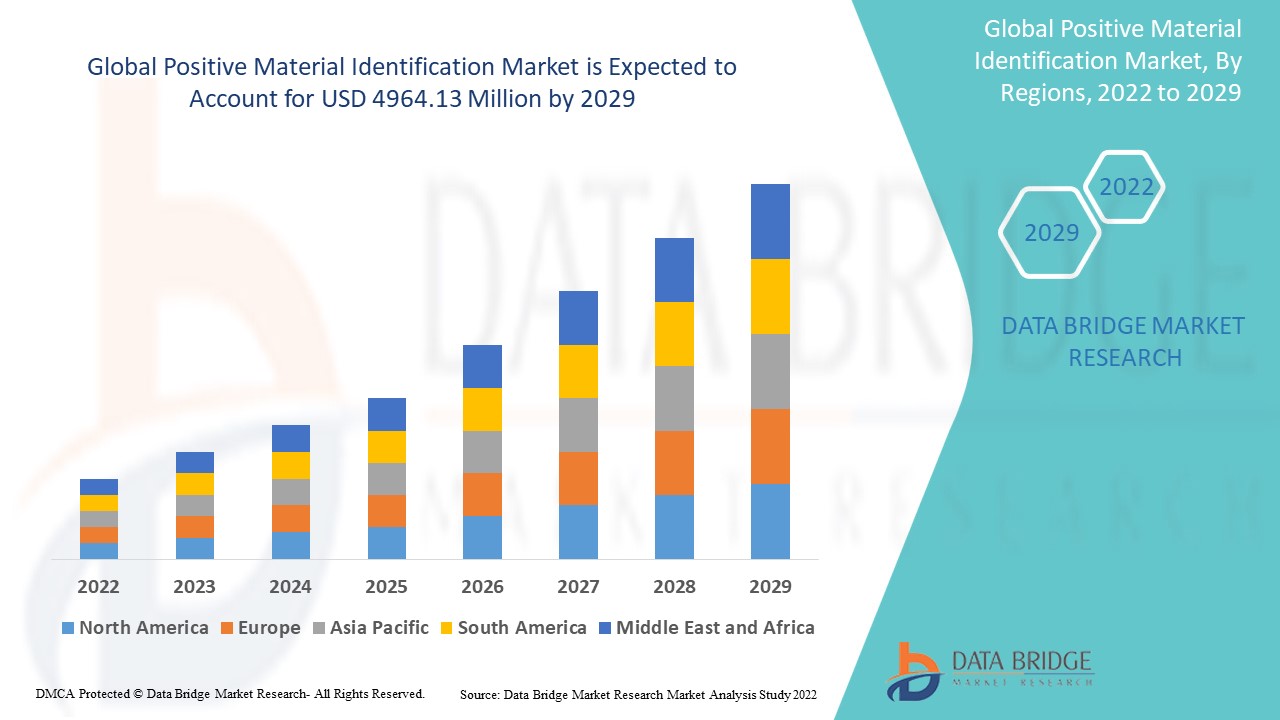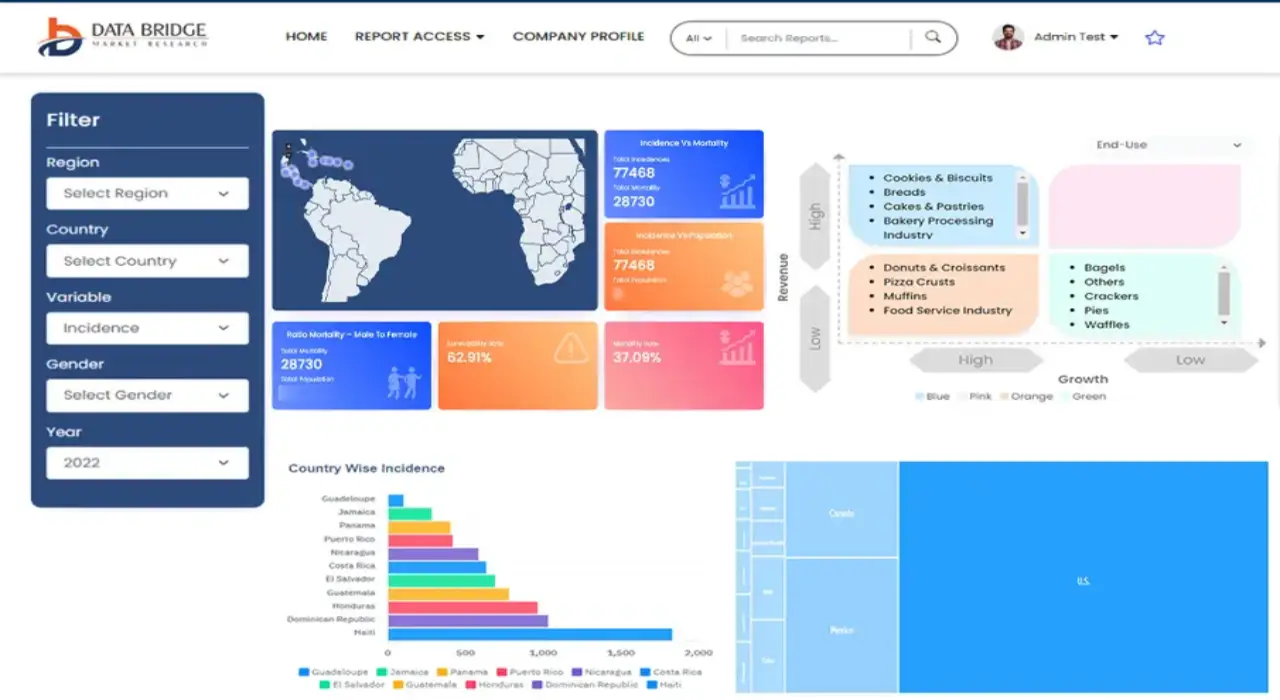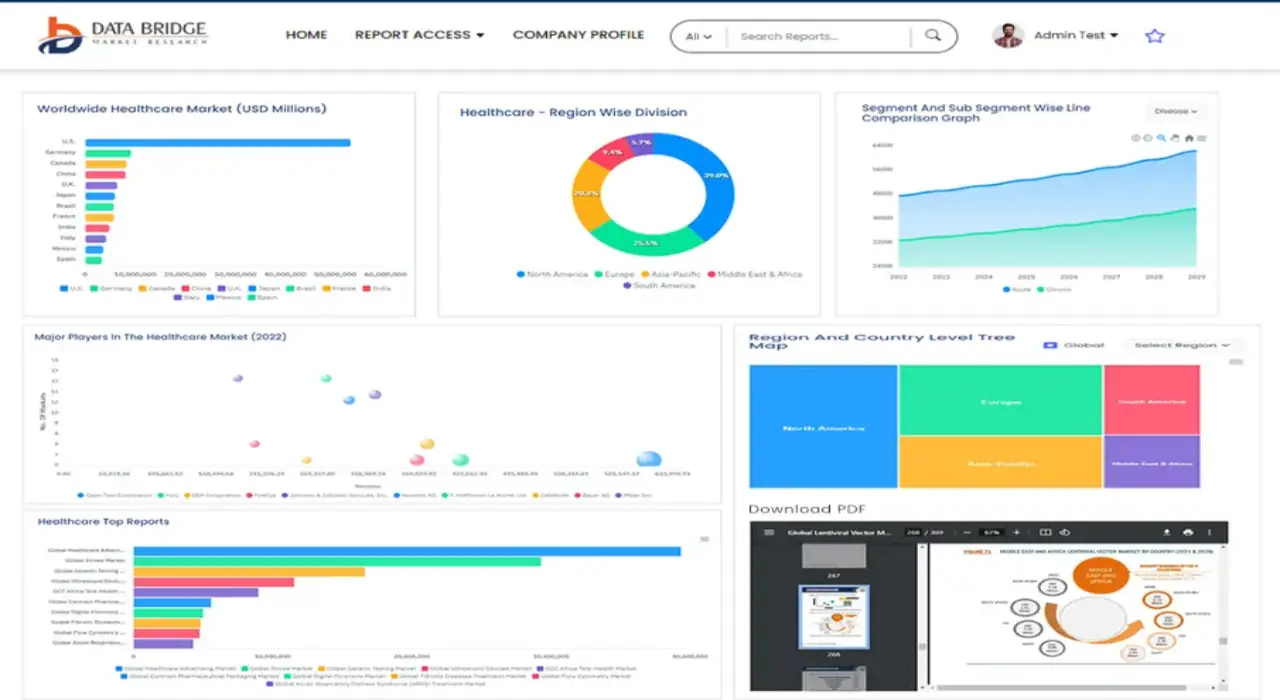Global Positive Material Identification Market
Tamanho do mercado em biliões de dólares
CAGR :
% 
 USD
2,783.40 Million
USD
4,964.13 Million
2021
2029
USD
2,783.40 Million
USD
4,964.13 Million
2021
2029
| 2022 –2029 | |
| USD 2,783.40 Million | |
| USD 4,964.13 Million | |
|
|
|
>Global Positive Material Identification Market, By Offering (Equipment, Services), Technique (X-Ray Fluorescence (XRF), Optical Emission Spectrometry (OES)), Form Factor (Portable Analyzers, Benchtop Analyzers), Industry (Oil and Gas, Metals and Heavy Machinery, Automotive, Scrap Recycling, Chemicals, Power Generation, Pharmaceutical) – Industry Trends and Forecast to 2029

Market Analysis and Size
Positive material identification has been gaining huge attention due to its ability to prevent the use of dangerous and highly hazardous chemicals. The need for PMI Testing is growing due to some of the primary problems in the oil and gas industrial sector, including accidents and damage pipe leakages, premature pipe replacements, and property damage. It is employed to verify the vital specifications of the parts used in pipes and other practical industrial applications.
Global Positive Material Identification Market was valued at USD 2783.40 million in 2021 and is expected to reach USD 4964.13 million by 2029, registering a CAGR of 7.50% during the forecast period of 2022-2029. In addition to the market insights such as market value, growth rate, market segments, geographical coverage, market players, and market scenario, the market report curated by the Data Bridge Market Research team also includes in-depth expert analysis, import/export analysis, pricing analysis, production and sales, and pestle analysis.
Report Scope and Market Segmentation
|
Report Metric |
Details |
|
Forecast Period |
2022 to 2029 |
|
Base Year |
2021 |
|
Historic Years |
2020 (Customizable to 2019 - 2014) |
|
Quantitative Units |
Revenue in USD Million, Volumes in Units, Pricing in USD |
|
Segments Covered |
Offering (Equipment, Services), Technique (X-Ray Fluorescence (XRF), Optical Emission Spectrometry (OES)), Form Factor (Portable Analyzers, Benchtop Analyzers), Industry (Oil and Gas, Metals and Heavy Machinery, Automotive, Scrap Recycling, Chemicals, Power Generation, Pharmaceutical) |
|
Countries Covered |
U.S., Canada, Mexico, Brazil, Argentina, Rest of South America, Germany, France, Italy, U.K., Belgium, Spain, Russia, Turkey, Netherlands, Switzerland, Rest of Europe, Japan, China, India, South Korea, Australia, Singapore, Malaysia, Thailand, Indonesia, Philippines, Rest of Asia-Pacific, U.A.E, Saudi Arabia, Egypt, South Africa, Israel, Rest of Middle East and Africa |
|
Market Players Covered |
Olympus Corporation (Japan), Thermo Fisher Scientific Inc (U.S.), Bruker (U.S.), Hitachi Ltd., (Japan), Ametek Inc., (U.S.)., Simadzu Corporation(Japan), Malvern Panalytical Ltd (Netherlands), SGS Group (Switzerland), Bureau Veritas (France), Intertek Group plc (U.K.), TÜV SÜD (Germany), Element Materials Technology (U.K.), TÜV Rheinland (Germany), Applus Services S.A. (Spain), TÜV Nord Group (Germany), Tribogenics (U.S.), Torontech (Canada), Sciaps (U.S.), QSX Instruments (U.S.) and Xenemetrix (Israel) |
|
Market Opportunities |
|
Market Definition
Positive Material Identification (PMI) is the process of analyzing and identifying materials using a variety of non-destructive techniques to ensure that the intended materials are the actual materials used. It can ascertain the metallic alloy makeup of a material. It is also a tried-and-true method that may be used in a lab or field using portable instruments.
Positive Material Identification Market Dynamics
This section deals with understanding the market drivers, opportunities, restraints and challenges. All of this is discussed in detail as below:
Drivers
- High Demand of Positive Material Identification
In general, mechanical integrity failures, such as pressured system rupture, stress corrosion cracking, and flow accelerated corrosion, are prominent causes of industrial accidents in the industrial sectors. To avoid probable product failure during manufacturing, positive material identification is used. In order to prevent failure, it is highly demanded in end-user sectors like oil and gas, power generation, and pharmaceutical plants. It is used for pre-service and in-service inspection of vital parts and welds. Positive Material Identification is a frequently used non-destructive testing technique that must adhere to a number of guidelines and regulations.
Furthermore, the increase in disposable income and the increase in the purchasing power among the consumers further increase the market demand. The factors such as growing number of large-scale infrastructure projects globally and a preference to outsource PMI testing and inspection services to third-party services has also increased the market growth.
Opportunities
- Government Regulations and Increased Awareness
The regulations concerned with material mix-ups mislabeled shipments and the growing number of large-scale infrastructure projects are estimated to generate lucrative opportunities for the market, which will further expand the positive material identification market's growth rate in the future. Additionally, the growing awareness about innovative quality control techniques coupled with the declining efficiencies of aging assets and the subsequent need for operational safety will also offer numerous growth opportunities within the market.
Restraints/Challenges
- High Costs
One of the barriers to market expansion is the high cost of positive material identification. The high cost of implementation for small size manufacturing plants further increases the overall cost of positive material identification (PMI) which hinders the market growth.
- Dearth of Skilled Personnel
The installations and the handling of various operations of positive material identification (PMI) requires skilled personnel. However, the lack of skilled personnel for handling this equipment further restricts the market growth. This factor is projected to pose as a challenge for the positive material identification market over the forecast period.
This positive material identification market report provides details of new recent developments, trade regulations, import-export analysis, production analysis, value chain optimization, market share, impact of domestic and localized market players, analyses opportunities in terms of emerging revenue pockets, changes in market regulations, strategic market growth analysis, market size, category market growths, application niches and dominance, product approvals, product launches, geographic expansions, technological innovations in the market. To gain more info on the positive material identification market contact Data Bridge Market Research for an Analyst Brief, our team will help you take an informed market decision to achieve market growth.
Global Positive Material Identification Market Scope
The positive material identification market is segmented on the basis of offering, technique, form factor and industry. The growth amongst these segments will help you analyze meagre growth segments in the industries and provide the users with a valuable market overview and market insights to help them make strategic decisions for identifying core market applications.
Offering
- Equipment
- Services
Technique
- X-Ray Fluorescence (XRF)
- Optical Emission Spectrometry (OES))
Form Factor
- Portable Analyzers
- Benchtop Analyzers
Industry
- Oil and Gas
- Metals and Heavy Machinery
- Automotive
- Scrap Recycling
- Chemicals
- Power Generation
- Pharmaceutical
Positive Material Identification Market Regional Analysis/Insights
The positive material identification market is analyzed and market size insights and trends are provided by country, offering, technique, form factor and industry as referenced above.
The countries covered in the positive material identification market report are U.S., Canada and Mexico in North America, Germany, France, U.K., Netherlands, Switzerland, Belgium, Russia, Italy, Spain, Turkey, Rest of Europe in Europe, China, Japan, India, South Korea, Singapore, Malaysia, Australia, Thailand, Indonesia, Philippines, Rest of Asia-Pacific (APAC) in the Asia-Pacific (APAC), Saudi Arabia, U.A.E, Israel, Egypt, South Africa, Rest of Middle East and Africa (MEA) as a part of Middle East and Africa (MEA), Brazil, Argentina and Rest of South America as part of South America.
North America dominates the positive material identification market because of the growing number of large-scale infrastructure projects within the region during the forecast period of 2022 to 2029.
Asia-Pacific is expected to witness significant growth during the forecast period of 2022 to 2029 due to the rapid expansion of the end-user industries like electronics, automotive, and healthcare sectors in the developing economies within the region.
The country section of the report also provides individual market impacting factors and changes in regulation in the market domestically that impacts the current and future trends of the market. Data points like down-stream and upstream value chain analysis, technical trends and porter's five forces analysis, case studies are some of the pointers used to forecast the market scenario for individual countries. Also, the presence and availability of global brands and their challenges faced due to large or scarce competition from local and domestic brands, impact of domestic tariffs and trade routes are considered while providing forecast analysis of the country data.
Competitive Landscape and Positive Material Identification Market Share Analysis
The positive material identification market competitive landscape provides details by competitor. Details included are company overview, company financials, revenue generated, market potential, investment in research and development, new market initiatives, global presence, production sites and facilities, production capacities, company strengths and weaknesses, product launch, product width and breadth, application dominance. The above data points provided are only related to the companies' focus related to positive material identification market.
Some of the major players operating in the positive material identification market are
- Olympus Corporation (Japan)
- Thermo Fisher Scientific Inc (U.S.)
- Bruker (U.S.)
- Hitachi Ltd., (Japan)
- Ametek Inc., (U.S.)
- Simadzu Corporation(Japan)
- Malvern Panalytical Ltd (Netherlands)
- SGS Group (Switzerland)
- Bureau Veritas (France)
- Intertek Group plc (U.K.)
- TÜV SÜD (Germany)
- Element Materials Technology (U.K.)
- TÜV Rheinland (Germany)
- Applus Services S.A. (Spain)
- TÜV Nord Group (Germany)
- Tribogenics (U.S.)
- Torontech (Canada)
- Sciaps (U.S.)
- QSX Instruments (U.S.)
- Xenemetrix (Israel)
SKU-
Obtenha acesso online ao relatório sobre a primeira nuvem de inteligência de mercado do mundo
- Painel interativo de análise de dados
- Painel de análise da empresa para oportunidades de elevado potencial de crescimento
- Acesso de analista de pesquisa para personalização e customização. consultas
- Análise da concorrência com painel interativo
- Últimas notícias, atualizações e atualizações Análise de tendências
- Aproveite o poder da análise de benchmark para um rastreio abrangente da concorrência
Metodologia de Investigação
A recolha de dados e a análise do ano base são feitas através de módulos de recolha de dados com amostras grandes. A etapa inclui a obtenção de informações de mercado ou dados relacionados através de diversas fontes e estratégias. Inclui examinar e planear antecipadamente todos os dados adquiridos no passado. Da mesma forma, envolve o exame de inconsistências de informação observadas em diferentes fontes de informação. Os dados de mercado são analisados e estimados utilizando modelos estatísticos e coerentes de mercado. Além disso, a análise da quota de mercado e a análise das principais tendências são os principais fatores de sucesso no relatório de mercado. Para saber mais, solicite uma chamada de analista ou abra a sua consulta.
A principal metodologia de investigação utilizada pela equipa de investigação do DBMR é a triangulação de dados que envolve a mineração de dados, a análise do impacto das variáveis de dados no mercado e a validação primária (especialista do setor). Os modelos de dados incluem grelha de posicionamento de fornecedores, análise da linha de tempo do mercado, visão geral e guia de mercado, grelha de posicionamento da empresa, análise de patentes, análise de preços, análise da quota de mercado da empresa, normas de medição, análise global versus regional e de participação dos fornecedores. Para saber mais sobre a metodologia de investigação, faça uma consulta para falar com os nossos especialistas do setor.
Personalização disponível
A Data Bridge Market Research é líder em investigação formativa avançada. Orgulhamo-nos de servir os nossos clientes novos e existentes com dados e análises que correspondem e atendem aos seus objetivos. O relatório pode ser personalizado para incluir análise de tendências de preços de marcas-alvo, compreensão do mercado para países adicionais (solicite a lista de países), dados de resultados de ensaios clínicos, revisão de literatura, mercado remodelado e análise de base de produtos . A análise de mercado dos concorrentes-alvo pode ser analisada desde análises baseadas em tecnologia até estratégias de carteira de mercado. Podemos adicionar quantos concorrentes necessitar de dados no formato e estilo de dados que procura. A nossa equipa de analistas também pode fornecer dados em tabelas dinâmicas de ficheiros Excel em bruto (livro de factos) ou pode ajudá-lo a criar apresentações a partir dos conjuntos de dados disponíveis no relatório.














